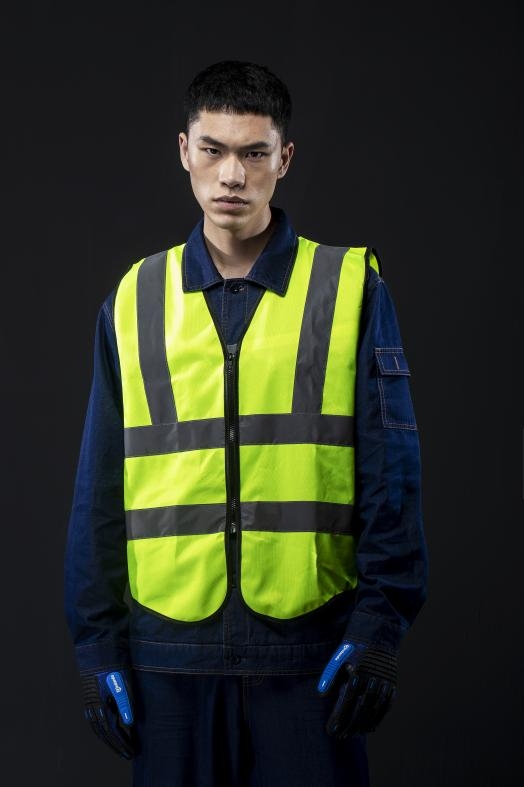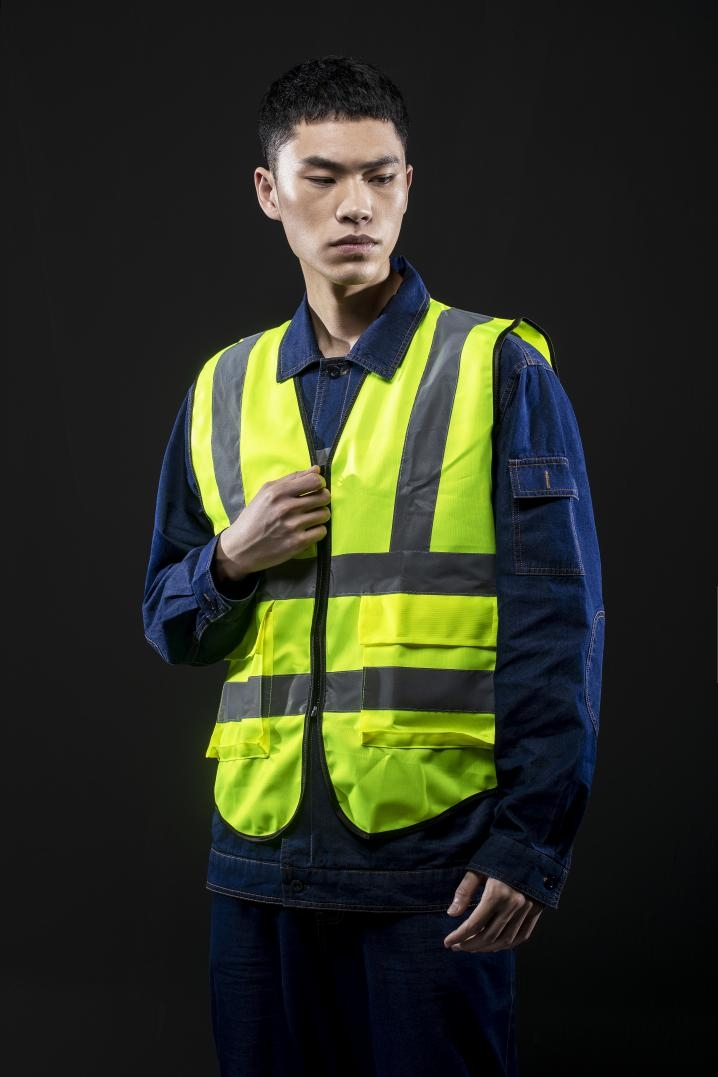Shine Bright: The Importance of High Visibility Vests
High visibility vests, essential in numerous industries, are designed to enhance visibility and ensure safety in various work environments. These vests are critical in preventing accidents and protecting workers by making them more noticeable, especially in low-light conditions or areas with heavy machinery. Andandar boasts a professional R&D team and Innovation Center of Excellence (CIE), which significantly contributes to the advancement of core technology in safety gear. Several core patents have been developed through their efforts, enabling Andanda to integrate digital and safety protection technologies. By combining these innovations, Andanda offers comprehensive solutions for personal protective equipment (PPE) procurement, ensuring high-quality products and professional industry-specific solutions for customers.

High Visibility Vest Design and Features
High-visibility vests undergo meticulous design to optimize safety and visibility across diverse work settings. Primarily crafted from reflective materials and fluorescent colors, these vests ensure heightened visibility, particularly in low-light or high-traffic environments.
Material and Construction
lReflective Materials: Strategically placed reflective tapes or strips amplify visibility by reflecting light from all angles, even in dim conditions.
lFluorescent Colors: Vibrant hues like neon yellow, orange, or lime green are prevalent in high-visibility vests, bolstering daytime visibility against typical work backdrops.
Standards and Classifications
Different visibility levels are delineated by standards such as ANSI/ISEA in the United States and EN ISO 20471 in Europe, which classify vests based on reflective properties and fluorescent background materials. ANSI/ISEA standards segment vests into three tiers—Class 1, Class 2, and Class 3—tailored to varying risk levels and environmental exposures. Similarly, EN ISO 20471 categorizes vests into three classes, aligning closely with ANSI/ISEA criteria to determine visibility thresholds.
Types of High Visibility Vests
- Industrial Vests: Engineered for industrial environments like construction sites, warehouses, and manufacturing facilities, these vests often integrate additional pockets and robust materials to withstand demanding conditions.
- Emergency Services Vests: Customized for emergency response professionals such as police, firefighters, and paramedics, these vests may feature radio pockets, reflective badges, and waterproofing to facilitate their duties effectively.
- Recreational Vests: Employed in activities like cycling, jogging, or hiking, these vests prioritize lightweight, breathable materials to ensure comfort during extended wear while maintaining optimal visibility for safety on roads or trails.
Legal Requirements and Regulations
Stringent occupational safety and health regulations mandate the utilization of high-visibility clothing across numerous industries to mitigate accident and injury risks. These regulations, contingent on region, often delineate specific mandates for various sectors and activities.
Overview of Regulations
The Occupational Safety and Health Administration (OSHA) in the United States mandates employers to furnish suitable high-visibility clothing for workers exposed to vehicular traffic or low-light conditions, as outlined in OSHA Standard 29 CFR 1910.132. Similarly, the Health and Safety Executive (HSE) in the United Kingdom issues guidelines on high visibility clothing usage under the Personal Protective Equipment at Work Regulations 1992 (as amended).
Specific Requirements
Industries may impose bespoke high-visibility clothing prerequisites predicated on risk levels and environmental exigencies. For instance, highway or construction site workers might necessitate Class 2 or Class 3 vests, whereas those in less perilous environments may suffice with Class 1 variants. Regulations might additionally stipulate factors like reflective tape positioning, width specifications, color standards for fluorescent materials, and maintenance protocols for high-visibility garments to ensure adherence to safety standards and optimal functionality.

Importance in Various Sectors
High visibility vests are pivotal in ensuring safety across diverse sectors, offering protection and visibility in environments where risks are heightened.
Construction and Road Work
In construction zones and road work sites, high visibility vests serve as a crucial safeguard against vehicular accidents. By enhancing the visibility of workers to motorists and heavy machinery operators, these vests significantly reduce the likelihood of collisions, thereby safeguarding the well-being of workers.
Emergency Services
High visibility vests are indispensable for personnel in emergency services such as police, firefighters, and EMS (Emergency Medical Services). These vests enhance visibility during critical operations, enabling swift identification and coordination in potentially chaotic situations. Whether directing traffic, extinguishing fires, or providing medical assistance, the heightened visibility offered by these vests is instrumental in ensuring effective response and safety for both responders and the public.
Transportation and Warehousing
In transportation hubs like airports, docks, and logistics centers, as well as in warehouses, high-visibility vests are paramount for accident prevention. They aid in the clear identification of personnel amidst bustling activities, reducing the risk of collisions involving vehicles, equipment, and pedestrians. Workers can operate with heightened awareness and safety by maintaining high visibility in these dynamic environments.
Recreational Use
Beyond professional settings, high visibility vests also find utility in recreational activities such as cycling and running. By increasing visibility to motorists, these vests enhance safety for outdoor enthusiasts, reducing the risk of accidents and promoting safer engagements in shared spaces.
Benefits of High Visibility Vests
High visibility vests offer a multitude of benefits, ranging from tangible safety enhancements to psychological impacts, fostering a culture of safety and compliance.
Enhancing Safety
The primary benefit of high visibility vests is the reduction of accidents and fatalities in various settings. By significantly improving the visibility of wearers, these vests mitigate the risk of collisions and accidents, thereby safeguarding lives and preventing injuries.
Compliance
High visibility vests facilitate compliance with legal and workplace safety standards. By adhering to regulations mandating the use of high-visibility clothing in specific industries and activities, organizations demonstrate their commitment to ensuring the safety and well-being of their workforce.
Psychological Impact
High visibility vests contribute to the creation of a safety-conscious environment within workplaces and communities. By visibly prioritizing safety through these vests, organizations instill a sense of responsibility and awareness among workers and the public, fostering a culture where safety is paramount.
Future Trends and Innovations
Advancements in Materials and Design
Anticipated developments in materials science and design engineering will revolutionize high-visibility vests. Lightweight yet durable fabrics, along with advanced reflective materials and ergonomic designs, promise improved comfort, durability, and overall effectiveness.
Smart Technology and IoT Integration
The future of high visibility vests lies in seamless integration with smart technology and the Internet of Things (IoT), ushering in enhanced safety features. With embedded sensors, GPS tracking, and communication capabilities, these vests will enable real-time monitoring of the wearer’s location, vital signs, and environmental conditions. Such integration not only bolsters worker safety but also streamlines coordination and response during emergencies.
Final Words
High visibility vests stand as indispensable guardians of safety across industries, ensuring workers are seen and protected in various environments. As beacons of visibility, Andanda’s vests mitigate the risk of accidents and injuries, safeguarding lives in construction zones, emergency situations, transportation hubs, and recreational activities. With ongoing innovations in materials, design, and integration with smart technology, the future of high-visibility vests promises even greater levels of safety and effectiveness. By shining brightly amidst evolving workplace landscapes, high visibility vests continue to illuminate the path towards enhanced safety and well-being for workers worldwide.

